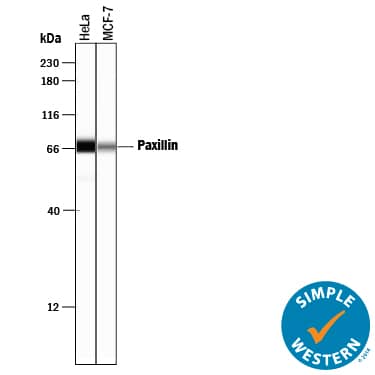Human/Mouse/Rat Paxillin Antibody
R&D Systems, part of Bio-Techne | Catalog # AF4259


Key Product Details
Species Reactivity
Validated:
Cited:
Applications
Validated:
Cited:
Label
Antibody Source
Product Specifications
Immunogen
Asn59-Ser274
Accession # P49023
Specificity
Clonality
Host
Isotype
Scientific Data Images for Human/Mouse/Rat Paxillin Antibody
Detection of Human/Mouse/Rat Paxillin by Western Blot.
Western blot shows lysates of HeLa human cervical epithelial carcinoma cell line, CCD-1070Sk human foreskin fibroblast cell line, A431 human epithelial carcinoma cell line, HepG2 human hepatocellular carcinoma cell line, and MCF-7 human breast cancer cell line. PVDF membrane was probed with 1 µg/mL of Sheep Anti-Human/Mouse/Rat Paxillin Antigen Affinity-purified Polyclonal Antibody (Catalog # AF4259) followed by HRP-conjugated Anti-Sheep IgG Secondary Antibody (Catalog # HAF016). A specific diffuse band was detected for Paxillin at approximately 65 to 70 kDa (as indicated). This experiment was conducted using Immunoblot Buffer Group 1.Paxillin in HUVEC Human Cells.
Paxillin was detected in immersion fixed HUVEC human umbilical vein endothelial cells using Sheep Anti-Human/Mouse/Rat Paxillin Antigen Affinity-purified Polyclonal Antibody (Catalog # AF4259) at 10 µg/mL for 3 hours at room temperature. Cells were stained using the NorthernLights™ 557-conjugated Anti-Sheep IgG Secondary Antibody (red; Catalog # NL010) and counterstained with DAPI (blue). Specific staining was localized to actin filament tips and cytosol. View our protocol for Fluorescent ICC Staining of Cells on Coverslips.Detection of Human Paxillin by Simple WesternTM.
Simple Western lane view shows lysates of HeLa human cervical epithelial carcinoma cell line and MCF‑7 human breast cancer cell line, loaded at 0.2 mg/mL. Specific bands were detected for Paxillin at approximately 70 & 69 kDa (as indicated) using 50 µg/mL of Sheep Anti-Human/Mouse/Rat Paxillin Antigen Affinity-purified Polyclonal Antibody (Catalog # AF4259) . This experiment was conducted under reducing conditions and using the 12-230 kDa separation system.Applications for Human/Mouse/Rat Paxillin Antibody
Immunocytochemistry
Sample: Immersion fixed HUVEC human umbilical vein endothelial cells
Simple Western
Sample: HeLa human cervical epithelial carcinoma cell line and MCF‑7 human breast cancer cell line
Western Blot
Sample: HeLa human cervical epithelial carcinoma cell line, CCD-1070Sk human foreskin fibroblast cell line, A431 human epithelial carcinoma cell line, HepG2 human hepatocellular carcinoma cell line, and MCF-7 human breast cancer cell line
Formulation, Preparation, and Storage
Purification
Reconstitution
Formulation
Shipping
Stability & Storage
- 12 months from date of receipt, -20 to -70 °C as supplied.
- 1 month, 2 to 8 °C under sterile conditions after reconstitution.
- 6 months, -20 to -70 °C under sterile conditions after reconstitution.
Background: Paxillin
The cytoskeletal adaptor protein Paxillin is found at the interface between actin filaments and the plasma membrane. Paxillin localizes to focal adhesions, where it provides a platform for the integration and coordination of adhesion- and growth factor-related signals. Paxillin phosphorylation is required for integrin-mediated cytoskeletal reorganization, and may play a role in the disassembly of focal adhesions and stress fibers during cellular transformation. Increased Paxillin protein levels have also been reported in several malignancies, including renal, lung, and breast carcinomas.
Alternate Names
Gene Symbol
UniProt
Additional Paxillin Products
Product Documents for Human/Mouse/Rat Paxillin Antibody
Product Specific Notices for Human/Mouse/Rat Paxillin Antibody
For research use only

